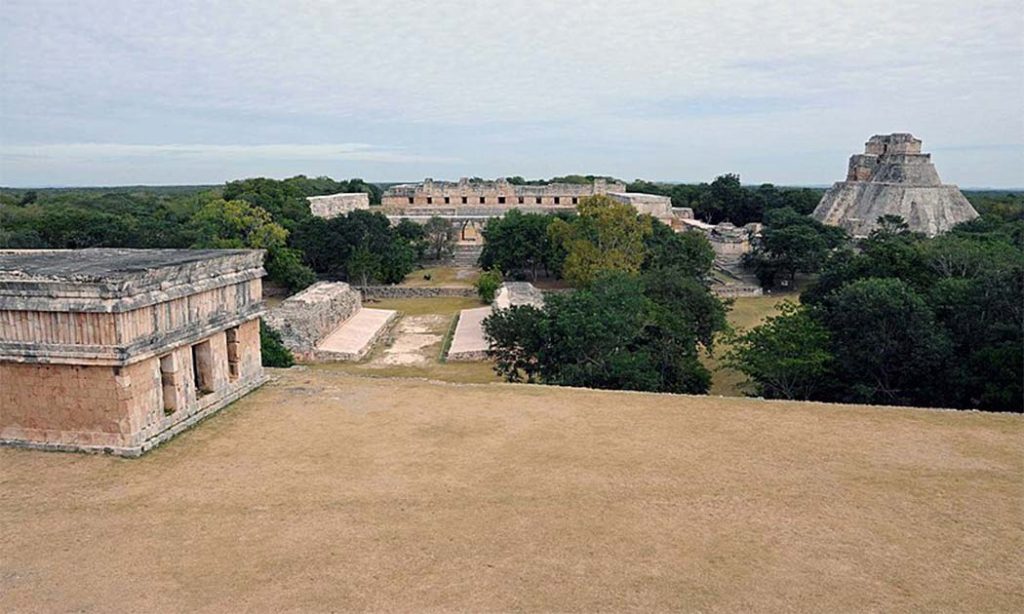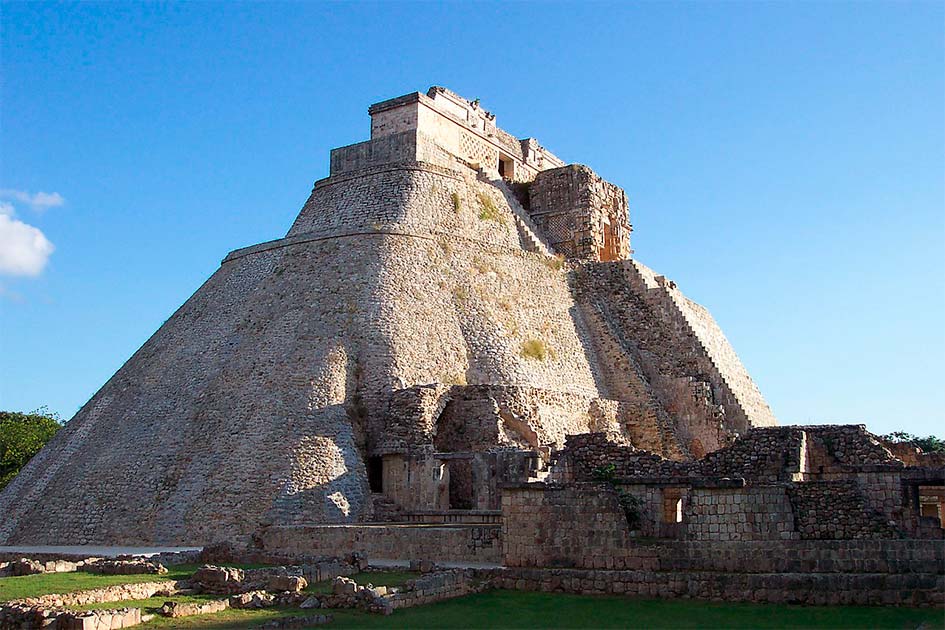Nestled within the lush landscapes of the Yucatan Peninsula, the ancient Mayan city of Uxmal is an unusual site, combining unique architecture with Mayan mythology. At the heart of this archaeological marvel stands the Pyramid of the Magician, a captivating structure that defies convention with its unique elliptical design.
This exceptional cityscape boasts a rich tapestry of history and legend, with the tale of a dwarf and a witch building the temple and weaving magic and mystique into the very stones of Uxmal.
The Magic Egg
Due to the fact the legend of the Pyramid of the Magician wasn’t documented in ancient texts the only versions of the legend we have are oral retellings that have been passed down over the years by the indigenous Maya people. Exactly how old the stories are, as well as the pyramid’s original name is unknown. There are many different versions of the story with relatively minor variations.
The most well-known and best-recorded version of the legend was told to John Lloyd Stephens, an American explorer, writer, and diplomat who made two visits to the site between 1839 and 1841. It was he who made the pyramid famous in his book, Incidents of Travel in the Yucatan. In 1840 Stephens interviewed a local Maya native and was told the following story.
The story tells how long ago where the pyramid now stands was a hut owned and lived in by an old woman, said to be a witch. This old woman one day began to mourn because she had no children.

Being a witch, her solution was to use her magic make a child. She took an egg, wrapped it in cloth, and hid it away in the corner of her hut. She checked on the egg daily until one day a small, baby-like creature emerged from her egg.
Overjoyed, the old witch claimed the baby as her son. She nursed it, loved it, and took such loving care of it that within a year it had developed to the point that it was walking and talking like a man, despite its diminutive stature. The child soon stopped growing but she was incredibly proud of her son and told him one day he would be a great lord or king.
- The “Hand Made Mountain”: Cholula, the Largest Pyramid in the World
- Why did the Maya Civilization Collapse?
Not long after she told her son to approach the house of the local Governor so that the dwarf might challenge the King to a trial of strength. At first, the dwarf refused but his mother insisted, being a dutiful son, he finally agreed. Seeing no threat, the king’s guards let him in, and the king agreed to the dwarf’s challenge.
The trial was simple, the king demanded the dwarf lift a stone weighing three arrobas (an old Spanish unit of weight) equal to 34 kg (75 pounds) today. The terrified dwarf ran away crying back to his mother, whom he told he could not do it. However, the witch was old and wise and sent her son straight back to the king with a message.
He told the king to lift the stone first and then he would do so in turn. Sure enough, the king lifted the stone and the dwarf followed suit. A little worried, the kings spent the rest of the day testing the dwarf who passed an increasingly difficult test. Whatever the king could do, it seemed the dwarf could too.
Building the Pyramid
The embarrassed and outraged king had soon had enough and decided to give the dwarf an impossible task. He must build a house taller than any other building in the city. He only had one night and if he failed the king would put him to death.
Once again, the poor dwarf ran back to his mother. She told him not to give up and go straight to bed. The next morning the kingdom awoke and found the Pyramid of the Magician finished and towering over the rest of the city.
The king was displeased and summoned the dwarf. He had come up with another test and ordered the dwarf to go and fetch two bundles of Cogoil wood, a particularly hardy wood. First, the king would break the planks over the dwarf’s head and then the dwarf would do likewise.
The son returned to his mother one final time. The witch told him to calm down and placed a magic tortilla on his head. The trial was performed in front of the city’s most rich and powerful. The king broke stick after stick over the dwarf’s head to no effect. He tried to back out of his own trial but knew it was too late.
The second stick the dwarf cracked over the king’s head smashed his skull to pieces. The king died at the dwarf’s feet and the dwarf was made the new King. He went on to rule over Uxmal for many years.
Other versions cut out the old witch in favor of aspects which tie into wider Maya mythology. In one popular version, the dwarf is a god called Itzamma or Itzamna and he built the pyramid himself using magic.
Itzamma was an important creator god and magician in Mayan mythology. Other versions depict the dwarf as a normal boy (not hatched from an egg) who is magically matured overnight by the witch.
Then there is the version that appears in a modern Uxmal tourist guide, which tells that it was long prophesied that a boy would one day lead Uxmal “not born of woman.” When this boy approached the king, he ordered him executed but declared he would be spared if he could complete three impossible tasks, including building the pyramid. This version is similar to the one told to Stephens but removes the competition element and the king’s death.
Local Mythology
The origin of the legend associated with the Pyramid of the Magician in Uxmal can be traced back to the oral traditions of the area’s indigenous Maya people. Passed down through generations, these narratives have been verbally transmitted as part of the cultural heritage of the region. While the specific origin or authorship of the legend remains elusive due to the absence of written records, it is deeply rooted in the collective consciousness of the Mayan community.

The legend likely emerged as a way to explain the extraordinary and unique features of the Pyramid of the Magician, such as its unconventional elliptical shape and the rapid construction attributed to the mystical dwarf, Itzamna. Archaeologists believe the massive pyramid took three centuries to build and was created by the traditional practice of superimposition, which means the pyramid grew as new structures were built on top of old ones.
Completed around 1000 AD, the pyramid was built during the Late Classic period which saw the Maya civilization begin to decline. With no written records, later generations told the Uxmal legend to explain the existence of a massive building they could not otherwise explain.
This means the story doesn’t really connect to the region’s wider Mayan mythology (except the version where the dwarf is really Itzamna). While the temple itself does have ties to the Mayan religion the legend of the pyramid itself stands separate, a story created by people who came after to explain something they couldn’t.
As a result, in the Pyramid of the Magician in Uxmal we find a combination of myth and history. Rooted in the oral traditions of the Mayan people, the legend encapsulates the profound cultural and spiritual significance bestowed upon this architectural marvel.
After the Mayan civilization collapsed the ancestors of its population were left with architectural marvels they couldn’t explain, resulting in stories like the legend of the Pyramid of the Magician. When our civilization eventually ends, what stories will those who follow us come up with to explain our achievements?
Top Image: The Pyramid of the Magician at Uxmal. Source: Anton Ivanov Photo / Adobe Stock.